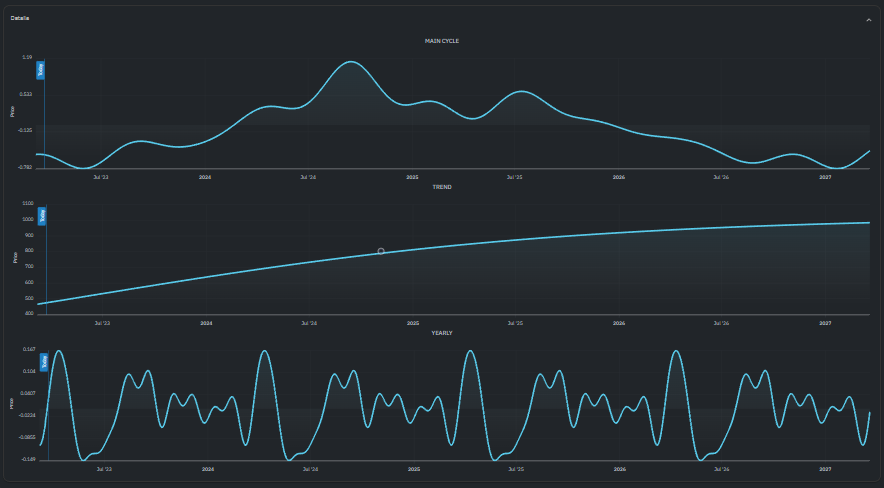20 Great Ideas For Choosing AI Stock Predicting Websites
20 Great Ideas For Choosing AI Stock Predicting Websites
Blog Article
Top 10 Tips To Evaluate The Strategy Customization Of Ai Trading Platforms
AI stock-predicting/analyzing platforms offer numerous options for customization that allow users to adapt their platform to their own trading goals in terms of risk-taking, as well as market condition. A platform offering a range of customizable options can help you improve your trading. Here are 10 top suggestions to help you assess the ability of the platform to tailor your strategy:
1. Evaluate Pre-Built Strategy Templates
Variety of templates: Check if the platform offers various pre-designed strategies that can be used for various trading styles (e.g., swing trading, day trading, long-term investment).
The ease of use is a good indication.
Performance history: Check if the platform provides historical performance data for pre-built strategies.
2. Assess the effectiveness of Custom Strategy Creation
Drag-and-drop platforms: Select platforms that have drag-and-drop interfaces that let you easily develop personalized strategies.
Look into the options for coding on the platform. Advanced users may want to use custom scripting languages (e.g. Python or R).
Flexibility - Ensure that the platform you select permits you to set rules for entry and exit, parameters to manage risk, as well as other important components of your strategic plan.
3. Check for Backtesting Capabilities
Data historical: See if there are enough records to backtest your strategies.
Configurable settings: Make sure to have the ability to change parameters during backtesting.
Performance metrics: Find out whether the platform has precise performance metrics such as win rate (e.g. Sharpe ratio) drawdown, win rate and other indicators to determine if the strategies have been tested back.
4. Evaluate Real-Time Strategy Testing
Paper trading Try out strategies in real-time with simulation or paper trading.
Live testing: Find out whether you're able to test your strategies on real-world markets with only a small amount of capital.
Real-time Adjustments: Determine if you're able to make adjustments in real-time according to market conditions.
5. Assess integration with technical indicators
Check if there is an indicator library.
Custom indicators. You must ensure that you are able to design or implement customized indicators as part of your strategy.
Combination of indicators: Examine to see if the system supports combining multiple indicators for complex strategies.
6. Check for Risk Management Tools
Stop-loss/take-profit: Ensure the platform allows you to set stop-loss and take-profit levels within your strategies.
Position sizing: Determine whether you can establish rules for sizing positions (e.g. the amount that is fixed or a percentage of portfolio) to help manage the risk.
Risk-reward Ratio: Make sure that the platform is able to set individual risk-reward limits for strategies and trades.
7. Evaluate Multi-Asset Strategy Support
Asset classes: Make sure the platform is able to provide strategies for a variety of asset categories (e.g. stocks, ETFs or options, forex).
Cross-asset Strategies: Determine if it is possible to create strategies that mix various asset classes.
Market coverage - Verify that the platform is covered by markets you're in (e.g. US and international markets and copyright and so on.).
8. Review Automation & Execution
Automated trading: Make sure the platform can automate execution of strategies based upon defined rules.
Types of orders - Make sure that the platform can support a variety of order types that can be used to execute strategies (e.g. stop limit, market or stop).
Latency: Make sure that the platform has a low latency when trading, especially if you are using high-frequency strategies.
9. Check for Strategy Optimizing Tools
Parameter optimization. Make sure your platform allows you to improve the parameters of your strategy (e.g. Grid search, Genetic algorithms).
Machine learning Integration: Determine whether a platform incorporates machine-learning to refine and optimize strategy.
Scenario analysis: Verify that the platform has the ability to test strategies under different market conditions (e.g. volatile bull, volatile, or bear).
10. Review User Feedback and Community Support
User reviews: Examine user feedback to evaluate the platform's capability to tailor strategies.
Community forums. Check if users are able to share information and discuss their methods in a lively community.
Support tools. Check for webinars or tutorials that can help you create and optimize your strategies.
Bonus Tips
Trial period: Try the customization options of the platform for free with a trial or demo.
Scalability - Ensure that the platform you select can adapt to your changing trading strategies.
Customer support: Check whether the platform is able to provide assistance with strategy-related issues or queries.
By following these tips to evaluate the capabilities to customize strategies of AI stock predicting/analyzing trading platforms, ensuring you choose one that matches your objectives in trading and allows you to apply and refine your strategies efficiently. A platform that is robustly customizable capabilities will allow you to adjust to changing market conditions and enhance the performance of your trading. Check out the top stock analysis app blog for site advice including free ai investing app, ai trading platform, ai trade, best copyright prediction site, best ai trading platform, ai for trading, best stocks to invest in, incite, ai stock predictions, best ai copyright and more.
Top 10 Tips To Assess The Risk Management Of Ai Stock Predicting/Analysing Trading Platforms
Risk management is a key element of every AI trading platform. It can help protect your capital while minimizing potential losses. A platform with robust risk management tools will aid you in managing turbulent markets and make informed choices. Here are 10 top tips to help you assess the risk management capabilities of these platforms.
1. Examine Stop-Loss features and Take Profit Features
Flexible levels: Ensure that the platform lets you set stop-loss and take-profit levels for specific strategies or trades.
Find out if the platform allows for trailing stops. They automatically adjust themselves as markets shift in your direction.
Check if your platform allows you to place stop-loss orders that ensure the close of your trade at the price stipulated, even on volatile markets.
2. Tools to Measure Positions
Fixed amount: Check that the platform you are using allows you to set position sizes in accordance with a set amount.
Percentage in your portfolio Manage your risk by determining the size of your portfolio proportionally in terms of per percentage.
Risk-reward percentage: Examine to see if it is possible to determine the risk-reward ratio for specific strategies or trades.
3. Make sure you are receiving assistance with diversification.
Multi-asset Trading: To diversify your investment portfolio, ensure that the trading platform you select can handle trading in a variety of asset classes.
Sector allocation: Determine if the platform offers tools for monitoring and managing exposure to sectors.
Geographic diversification: Make sure that the platform you trade on supports international markets in order to spread risk geographically.
4. Evaluation of Margin and Leverage controls
Margin requirements. Make sure you know the requirements for margin prior to trading.
Limits on leverage: See whether the platform allows users to set leverage limits to manage the risk exposure.
Margin Calls: Verify that the platform sends out timely notifications of margin calls to stop the liquidation of your account.
5. Assess the risk Analytics Reporting
Risk metrics: Ensure whether the platform has key risk metrics like Value at Risk, Sharpe ratio and Drawdown, for your portfolio.
Assessment of scenarios: Determine whether you are able to simulate different market scenarios on the platform to evaluate potential risks.
Performance reports - Verify that the platform includes specific performance reports, including risk adjusted returns.
6. Check for Real-Time Risk Monitoring
Portfolio monitoring: Ensure that the platform provides real-time tracking of the risk exposure to your portfolio.
Notifications and alerts. Check if the platform offers real-time notification of risk-related events.
Risk dashboards – Check to see if your platform has customized risk dashboards. This will provide you with a better overview of the risks that you face.
7. How to evaluate the results of Stress Testing and Backtesting
Test for stress: Ensure whether the platform allows you to stress-test your strategies or portfolios during extreme market conditions.
Backtesting. Find out if the platform allows for backtesting, which is the application of historical data to evaluate the risk and the performance.
Monte Carlo Simulations: Check if the platform utilizes Monte Carlo simulations in order to model and assess various possible outcomes.
8. Verify Compliance with Risk Management Regulations
Compliance with regulatory requirements: Ensure that the platform complies with relevant risk-management regulations (e.g. MiFID II, Reg T, in the U.S.).
Best execution : Check to find out if your platform uses best execution procedures. This will ensure that trades are executed for the best possible price, minimising slippage.
Transparency: Ensure that the platform offers clear and transparent disclosures of the risks.
9. Verify that the parameters are controlled by the user.
Custom risk rules - Make sure the platform permits for you to define your own risk management policies.
Automated Risk Controls Check whether the system is able to automate the enforcement of risk management policies in accordance with predetermined parameters.
Manual overrides Determine whether you are able to manually override the risk management system in the event of an emergency.
10. Review User Feedback and Case Studies
User feedback: Read user reviews to evaluate the platform's ability to manage risk.
Case studies and testimonials They will showcase the risk management capabilities of the platform.
Community forums Find out if there is an active community of traders that share advice and strategies for managing risk.
Bonus Tips:
Trial time: You can make use of a demo or a no-cost trial to experience the risk management features on the platform.
Support for customers: Ensure whether the platform offers the best support to queries or concerns related to the management of risk.
Educational resources: Find out if there are any educational resources available on the best practices for managing risk.
By following these tips you can evaluate the capability of an AI software for analyzing and predicting stocks to manage the risk. This will allow you to select a system that protects your capital and minimizes the possibility of losses. To make trading successful and manage volatile markets, strong risk management tools are vital. Take a look at the recommended get more information for ai bot for copyright trading for website examples including ai investment stock, ai for stock trading, free ai trading bot, ai investing tools, chart ai trading, investing in ai stocks, stocks ai, best ai copyright to buy, ai investment stock, free ai investing app and more.